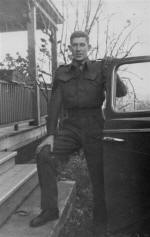by Colin Myles Standish
(reprinted with permission)
In tiny Stanley village, past the Repulse Bay Hotel, where young Canadians were bayoneted and thrown off steep cliffs, I stand in a Commonwealth military cemetery. I think of Laurence Binyon’s line that I always heard on Remembrance Day, back home in the Eastern Townships of Quebec, “at the going down of the sun and in the morning, we will remember them.”
 All
told, 20 Canadians are buried on this small bluff that served as the
last stand for the Canadian forces stationed here in the Second World
War. This is where my grandfather, Colin Alden Standish, was captured on
Christmas Day, 1941. I have finally made it to this place of family lore
and legend, of heroism and triumph, and inhumane pain and despair.
All
told, 20 Canadians are buried on this small bluff that served as the
last stand for the Canadian forces stationed here in the Second World
War. This is where my grandfather, Colin Alden Standish, was captured on
Christmas Day, 1941. I have finally made it to this place of family lore
and legend, of heroism and triumph, and inhumane pain and despair.
I find myself half-way around the world because of the Canadian battle for Hong Kong. My grandfather was a young man from rural Quebec when he enlisted in the Royal Rifles Regiment in 1940, destined to serve 1,377 days (three years, eight months) as a Prisoner of War in Japanese concentration camps, and to receive the Distinguished Conduct Medal for his bravery under fire. I came to Hong Kong to track down Canadian war sites and try to understand what he went through.
On December 8, 1941, the Japanese Army swarmed the border of Hong Kong’s New Territories. I can still see the remains of the concrete trench system, the Gin Drinkers’ Line, which stretches across the entire Hong Kong peninsula. Many parts are easily accessible, but some sections are filled with mud. A sign reading “Piccadilly” adorns one of the tunnels, which were all named after landmarks in London. Today the tunnels are guarded by roving bands of monkeys.
Sweating in the 30-plus heat, I hike the steep peaks of Hong Kong Island. The area known as the Wong Nai Chung Gap saw the heaviest fighting during the battle. The Gap overlooks a main pass between the mountains and it was a strategic position for the Japanese to capture the northern villages of Aberdeen and Stanley. All the pillboxes and bunkers remain as they were in the 1940s. I have a hard time imagining Japanese and Canadian bayonet charges up the steep mountainsides.
On December 18, the Japanese army on Kowloon crossed the Lye Mun Gap to Hong Kong Island under the cover of darkness. My grandfather and other young Quebeckers in the Royal Rifles found themselves under Japanese gun fire that night, before being forced to retreat to Tai Tam Reservoir in the Wong Nai Chung Gap and then to Stanley village. The rubble of the Canadian barracks still stand inside the fort, bearing witness to the ferocious battle with deep bullet holes and shrapnel scars.
My grandfather supplied the men in the fort until it was no longer possible to defend it. Then, he organized and executed a coordinated relief effort under heavy fire.
Most of the 290 Canadian men killed in the battle for Hong Kong are buried at Sai Wan Cemetery. In all, more than 1,500 Commonwealth graves dot the rolling grounds of the military graveyard. I attempt to ask the Chinese groundskeeper where the Canadians are buried. He doesn’t understand. But, as I turn away, maple leaves jump out from the tombstones in front of me. My back and shoulder tingle, moving up my neck. The rows of white headstones look out over a concrete jungle below. Among 30-story high-rises, this resting place seems very far away from home for these men.
Sham Shui Po was the main concentration camp for Canadian POWs. Today, Sham Shui Po exists in contrast to the horror it once inflicted on its inmates. I find Sham Shui Po is now a park, renowned for its swimming pool, and a place where children play on swing sets and the elderly play chess. I am disappointed to not find any official Canadian markers among the trees. The only remnants I find of the POW camp are the 1940s-era razor wire fences.
Sham Shui Po is where my grandfather was imprisoned before he left Hong Kong for Japan in December, 1943. There, he learned to build trains, memorize his concentration camp number ni-ku-go (25), eat rotten rice and insects (grasshoppers were his favourite), and avoid beatings. A slave labourer, he was starved and prodded into working 14-hour days in dangerous factories. At 6’2”, he weighed 95 pounds when he was freed in August, 1945.
I think of my grandfather when I visit his grave in Rougemont, Quebec. The ‘HK’ Hong Kong veteran symbol is etched at the head of his tombstone. Of the 1,975 Canadians who travelled to Hong Kong in 1941, 1,050 were injured and 560 never returned home. Another 87 came home legally blind, and 200 died before reaching 50. My grandfather, who lived to the age of 74, was in many ways a lucky man. To return home to my future grandmother, military decorations, and a thriving family business, he was still haunted by his experiences in the POW camps.
Back
in Canada, I think about the sacrifice made by men my age, and even
younger. I think of the devastation their deaths and injuries had on
rural Canada. My grandfather once wrote to his family: “When I come
home, my wandering days are over.” Though I am not sure if Hong Kong has
put to rest my wandering days, I feel I better understand the man whose
name I proudly share.
Colin Myles Standish